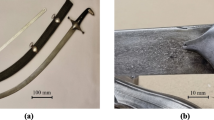The main distinguishing features of the Eastern Damascus sabers are considered according to the topological affiliation of the blade, which include the classical forms of Persian Shamshir, Indian Talwar, and Turkish Kilij. The need to consider the regional factor was indicated, which describes the affiliation of the Damascus saber with a particular region, where it was mounted with a national hilt, such as an Afghan Pulwar or Arab Saif. The structure of the edge section of the 18th century Damascus saber blade (Pulwar) has a characteristic carbide banding. In the process of topographic studies of the patterned surface, it was revealed that the shape of the main components of the Damascus pattern consists of individual characteristic elements, such as knottiness, wave crests (dunes), and hollows. Based on the nature of the pattern, the saber blade belongs to the Khorasan variety. It has been established that genuine Damascus steel is an inhomogeneous high carbon steel with an increased phosphorus content. The stoichiometric composition of the excess cementite and abnormally coarse eutectic carbides has been studied. It was found that the Eastern saber blade with a Damascus pattern is a unique technological solution of its time. The Damascus blade does not only consist of one wootz-ingot. Typically, separate sections of each one third of the blade are made of a combination of non-uniform crucible steels with different chemistry and structure. Each third of the blade is responsible for its own unique properties and performance characteristics. A full cycle of reconstruction of the genuine Damascus structure was carried out under the laboratory conditions using experimental alloys No. 1 and No. 2. It was shown that carbide inhomogeneity patterns and stoichiometric composition of the excess carbide phases in alloys No. 1 and No. 2 are completely identical to the patterns of the genuine Damascus structure of the 18th century Pulwar saber blade.









Similar content being viewed by others
References
N. F. Masal’skii, “Fabricating Damascus steel by a method used by Persians,” Gornyi Zhurnal, IV, No. 11-12, 233–248 (1841).
B. Zschokke, “Du Damasse et des Lamés de Damast,” Rev. de Metallurgie, 21, No. 11, 639–669 (1924).
I. S. Gaev, “Damascus steel and contemporary iron-carbon alloys,” Metall. Term. Obrab. Metallov., No. 9, 17–24 (1965).
Cl. Panseri, “Damascus steel in legend and in reality,” Gladius, No. 4, 5–66 (1965).
O. D. Sherby and J. Wadsworth, “Damascus steel,” Scientific American, 252, No. 2, 112–120 (1985).
F. N. Tavadze, B. G. Amaglobeli, and G. V. Inanishvili, “Mechanical properties of Damascus steel,” Soob. AN Gruz. SSR, No. 3 (113), 589–592 (1984).
V. A. Shcherbakov and V. P. Borsunov, Damascus Steel [in Russian], MISiS, Moscow (1996).
O.D. Sherby and J. Wadsworth, “Ultrahigh carbon steels, Damascus steel and superplasticity,” in: 9th Intern. Metallurgical and Materials Congress, Istanbul, Turkey (Preprint). June 11-15 (1997).
J. D. Verhoeven, A. N. Pendray, and W. E. Dauksch, “The key role of impurities in ancient Damascus steel blades,” J. of Metallurgy, 50, 58–64 (1998).
J. D. Verhoeven, “Pattern formation in wootz Damascus steel swords and blades,” Indian J. History of Science, No. 42 (2), 559–574 (2007).
I. N. Taganov and B. D. Kalinin, “The effect of phosphorus impurities on Damascus steel technology,” Metalloobrabotka, No. 2 (50), 40–46 (2009).
L. B. Arkhangel’skii, “Testing the cutting ability of historical Damascus steels,” Klinok – Traditsii i Sovremennost’, No. 33, 38–42 (2017).
J. D. Verhoeven, A. N. Pendray, W. E. Dauksch, and S. R. Wagstaff, “Damascus steel revisited,” J. Minerals, Metals & Materials Society, 70, No. 7, 1331–1336 (2018).
D. A. Sukhanov, “Influence of phosphorus impurity on the structure and nature of the destruction of the genuine Damascus steel,” Intern. J. Engineering Technologies and Management Research (IJETMR), No. 5 (4), 26–37 (2018).
D. A. Sukhanov and N. V. Plotnikov, “Mechanical properties of |Persian Damascus steel of the 18th century compared to contemporary tool steels,” Metallurg, No. 11, 50–60 (2019).
D. A. Sukhanov, “Specific features of the elements of topographic contour of the patterned macrostructures in Persian Damascus steel of the 18th century,” Metallurg, No. 2, 93–102 (2022).
A. A. Baikov, “On high-carbon phases in iron-carbon alloys,” Zhurnal Russkogo Metallurg. Obshchestva, No. 3, 21 (1914).
D. A. Sukhanov, L. B. Arkhangel'skii, and N. V. Plotnikova, “Nature of angular carbides in Damascus steel,” Metallurg, No. 1, 112–117 (2017).
Author information
Authors and Affiliations
Corresponding author
Additional information
Translated from Metallurg, Vol. 66, No. 11, pp. 115–124, November, 2022. Russian https://doi.org/10.52351/00260827_2022_11_115
Rights and permissions
Springer Nature or its licensor (e.g. a society or other partner) holds exclusive rights to this article under a publishing agreement with the author(s) or other rightsholder(s); author self-archiving of the accepted manuscript version of this article is solely governed by the terms of such publishing agreement and applicable law.
About this article
Cite this article
Sukhanov, D.A. Reconstruction of Genuine Damascus Structure of the 18th Century Eastern Pulwar Saber Blade. Metallurgist 66, 1481–1493 (2023). https://doi.org/10.1007/s11015-023-01463-x
Received:
Revised:
Accepted:
Published:
Issue Date:
DOI: https://doi.org/10.1007/s11015-023-01463-x




